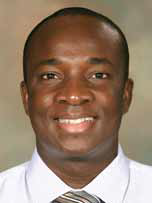#SCM16: Do We Really Need a Renal Sonogram for All Cases of AKI?
 Paul Adjei, MD (PA), from Rochester General Hospital in Rochester, New York, discusses his abstract for the National Kidney Foundation’s 2016 Spring Clinical Meetings (SCM16), What is the Utility of Routine Renal Ultrasound In the Evaluation and Management of Acute Kidney Injury in Hospitalized Patients?, with Dr. Kenar Jhaveri, AJKD Blog Editor.
Paul Adjei, MD (PA), from Rochester General Hospital in Rochester, New York, discusses his abstract for the National Kidney Foundation’s 2016 Spring Clinical Meetings (SCM16), What is the Utility of Routine Renal Ultrasound In the Evaluation and Management of Acute Kidney Injury in Hospitalized Patients?, with Dr. Kenar Jhaveri, AJKD Blog Editor.
AJKDblog: Why don’t you tell us a little about your research and abstract being presented at NKF 2016?
PA: Acute kidney injury (AKI) is a common problem in hospitalized patients, with an incidence increasing from approximately 25 to 40 per 1000 discharges over the last 15 years.
Although thorough work up of slowly progressive chronic renal disease often includes an ultrasound to image the kidneys for useful information, there are few helpful diagnostic reasons that can be discovered by use of an ultrasound in acute renal disease. This is especially true once a Foley catheter has been put in place to check for presence or absence of urine.
We have long observed therefore that the results of the ultrasound do not change therapy and wondered if this test is more suitable in a different scenario. This might include when reaching the limits of our diagnostic work up, or in a patient with a history of repeated infections or nephrolithiasis. Many providers order this test because they have been trained to do so as a knee-jerk reaction in the setting of AKI, without careful consideration of the additional information it might provide. Though the ultrasound is not exclusively ordered for hydronephrosis and obstruction, this is overwhelmingly the primary indication.
This study, therefore, was undertaken to confirm the theory that a routine ultrasound in a patient without relevant urologic history and who has had a Foley placed is of little therapeutic yield. We hypothesized that routine renal ultrasound in the evaluation of AKI in hospitalized patients is of low diagnostic yield, a waste of healthcare resources ($415 per study), and likely does not impact management.
AJKDblog: The renal ultrasound also helps in determining the timing of renal injury. Cortical thinning noted on sonogram can perhaps deter the clinician from performing a kidney biopsy. Did you look to non-hydronephrosis cases to see if a biopsy was based on the sonogram findings?
PA: Cortical thinning is a helpful ultrasound finding, and does factor into the thinking of possible biopsy, but we had no acute patients presenting with glomerulonephritis who had evidence of an acute change from a normal baseline, where this became critical. I wonder too about the genuine impact of an ultrasound compared to changes in creatinine or an active urinary sediment. Would the nephrologist hesitate to perform a biopsy even if there is suggestion of cortical thinning? In this scenario, the cortical thinning would likely be outweighed. Finally, if the patient is considered for a biopsy, all providers know that an ultrasound will likely be performed at the time of biopsy, given basic information such as ensuring two kidneys with grossly normal anatomy. In our patient cohort, in the non-hydronephrosis group (95% patients), incidental findings not immediately affecting patient care, including mostly renal cysts and “structural changes due to chronic kidney disease” were identified in 56% of patients. None of these patients had a kidney biopsy or an indication for one. Naturally, this may be sampling error.
AJKDblog: Where do you and group go from here?
PA: In this era of “high value care,” we need to use quality projects like this one to guide diagnostic work up. To this end, we (with my mentor Dr. Paul Bernstein) hope to work towards a prospective study to test our hypothesis more completely.
—
All Spring Clinical Meeting abstracts are available in the May issue of AJKD.
Check out more AJKDblog coverage of the NKF’s 2016 Spring Clinical Meetings (#SCM16)!

Leave a Reply